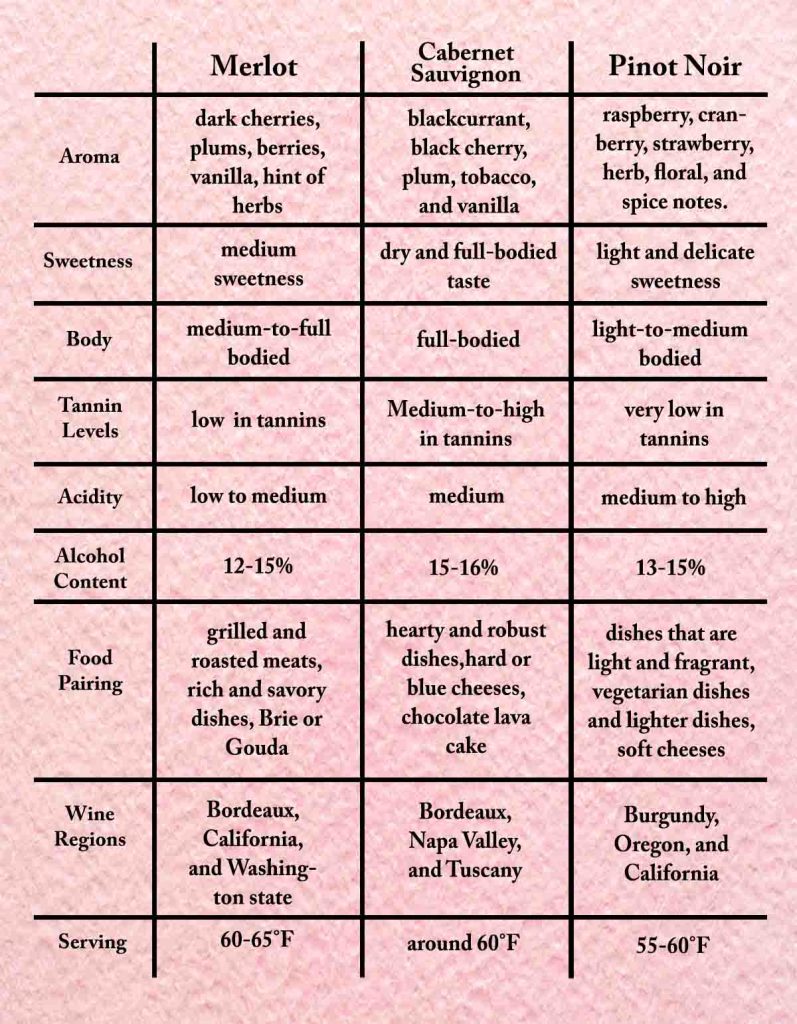Merlot vs Cabernet vs Pinot Noir
If you’re looking to try out a few new wines, then the tantalizing trio of Merlot vs Cabernet vs Pinot Noir may just be your ticket! Not only are these three varietals staples in both red and white winemaking alike – but they also offer an array of unique aromas & flavors that set them apart from each other. But what’s even more intriguing is how different they can taste depending on where they’ve been produced!
All varieties have their own stories & histories behind them; such as Cabernet being one of the oldest known grape varieties, or Pinot Noir’s flavorful complexity when made from select regions like Burgundy in France. With so much to compare & explore – let us decipher for ourselves if any one variety stands above the rest by taking a closer look into Merlot vs Cabernet vs Pinot Noir.
In this blog post, we’ll provide a clear comparison for three of three popular red wines: Merlot, Cabernet, and Pinot Noir. By the end of this post, you’ll have a better understanding of these wines and which one might be right for you.
An Overview of Merlot, Cabernet, and Pinot Noir
Nothing beats a good glass of red wine after a long day. Whether you’re out for a fancy dinner or relaxing at home, it’s always nice to have a bottle of your favorite red wine on hand. But with so many different types of red wine out there, it’s hard to know where to start. And our protagonists today have Merlot, Cabernet Sauvignon, and Pinot Noir. First, let’s take a quick look at these three wines.
Merlot
Merlot is a medium-bodied (or sometimes full) red wine that is known for its soft, smooth texture. It is one of the most commonly planted red wine grapes in the world and is grown in various regions, including Bordeaux, Italy, and California. Merlot is typically easy to drink and has a fruit-forward flavor profile. It also pairs well with a variety of foods, such as lamb, beef, pork, and pasta dishes. Overall, Merlot is a great red wine for those who are new to drinking red wine, or who want a wine that is easy to drink and pairs well with a range of foods.
Cabernet Sauvignon
Cabernet is a full-bodied red wine that is known for its bold, rich flavor. It is one of the most well-known red wine grapes and is grown in a variety of regions, including California, France, and Chile. Cabernet is typically tannic and has a higher alcohol content than some other red wines. It also tends to be more complex, with notes of blackberry, blackcurrant, and plum. Cabernet pairs well with foods that are equally bold and rich, such as steak, beef stew, dark chocolate, and strong or blue cheeses. Cabernet is a great red wine for those who want a bold, complex wine that pairs well with hearty meals.
Pinot Noir
Pinot Noir is a lighter-to-medium-bodied red wine that is known for its delicate flavor and aroma. It is grown in regions like Burgundy, Oregon, and California. Pinot Noir is typically earthy and has notes of blackberry, raspberry, strawberry, and hints of spices and earth. Because it is lighter and less tannic than other red wines, it pairs well with lighter foods like grilled fish, roasted chicken, seared salmon, mushroom risotto, and pasta dishes. Pinot Noir is a great red wine for those who want a lighter wine that is still flavorful and pairs well with a range of foods.
Merlot, Cabernet, and Pinot Noir are three popular red wines that each have their unique characteristics. Whether you’re new to the world of red wine or a seasoned connoisseur, understanding the differences between these three wines can help you choose the right bottle for your tastes and preferences.
Comparing the Flavors and Aromas of Merlot vs Cabernet vs Pinot Noir
The world of red wines can be daunting for those who are not well-versed in the language of wine. It can be difficult to differentiate between the various flavors and aromas that are present in each bottle. In this section, we’ll be comparing three main characters of this blog post: Merlot, Cabernet, and Pinot Noir. We’ll take a look at their aroma, sweetness, body, tannin levels, acidity, and alcohol content to help you make an informed decision the next time you’re in the mood for a glass of red.

Aroma: When it comes to aroma, Merlot is known for its fruity and earthy scent. It has notes of dark cherries, plums, berries, vanilla, and a hint of herbs. Cabernet Sauvignon, on the other hand, offers a more complex aroma, typically exhibiting fruity notes of blackcurrant, black cherry, and plum, whereas, with age, the aromas develop into herbal and oak-based scents like tobacco and vanilla. Pinot Noir is the lightest in this category with its aroma of red fruits such as raspberry, cranberry, and strawberry, along with herb, floral, and spice notes.
Sweetness: In terms of sweetness, Merlot is known for its medium sweetness, making it a good option for those who prefer a less dry taste. Cabernet has a drier and full-bodied taste, while Pinot Noir is known for its light and delicate sweetness.
Body: The body of a wine refers to its texture and weight. Merlot has a medium-to-full body, offering a silky and smooth texture. Cabernet has a full body, giving it a more robust and bold taste. Pinot Noir is known for its light-to-medium body and soft texture. Thus, the sweetness of these three wines is, respectively, Merlot – Pinot Noir – Cabernet.
Tannin Levels: Tannins are natural compounds found in red wines that give them their structure and texture. Pinot Noir has a lower tannin level, providing it with a smoother taste. Cabernet has a higher tannin level, offering a more complex and astringent taste. Merlot has a lower tannin level than Cabernet but higher than Pinot Noir, making it a good option for those who want a balance between smoothness and complexity.
Acidity: Acidity is an important factor in wine tasting as it can provide the wine with a crisp or tart taste. Merlot is known for its low acidity, offering a smooth and mellow taste. Cabernet has a higher acidity level, giving it a more vibrant and tart taste. Pinot Noir is in between with moderate acidity, providing a balance between sweetness and tartness.
Alcohol Content: Finally, the alcohol content of a wine can greatly affect its taste. Merlot has a lower alcohol content (12-15%), offering a milder taste. Cabernet has a higher alcohol content (15-16%), providing a more bold and full-bodied taste. Pinot Noir has a moderate alcohol content (13-15%), making it a good option for those who want a balance between the two.
The flavor profile of Merlot, Cabernet, and Pinot Noir can greatly differ based on their aroma, sweetness, body, tannin levels, acidity, and alcohol content. It’s important to note that everyone has taste preferences and what works for another person might not work for you.
Discovering the Unique Wine Regions for Merlot, Cabernet, and Pinot Noir
Wine is a complex drink that comes from different regions all around the world. Every wine region has unique characteristics that give its wines a distinct taste and quality. So now, we will explore the different wine regions where you can find the best Merlot, Cabernet, and Pinot Noir wines.
Merlot Wine Regions
Merlot wines are grown in various regions, but the most notable ones include Bordeaux, California, and Washington state. Bordeaux wines have high acidity levels and a complex flavor that blends well with the Merlot grape. California offers warmer regions that provide a more mature and full-bodied Merlot. In Washington state, the Merlot grapes are grown in cooler regions, which results in a balanced and fruit-forward wine.
Cabernet Wine Regions
Cabernet Sauvignon wines are grown in various regions, but the most notable ones are Bordeaux, Napa Valley, and Tuscany. Bordeaux wines are known for adding elegance, finesse, and complexity to Cabernet wines. Napa Valley is famed for producing bold, intense, and robust Cabernets wines. Tuscany’s offering varies from the bold and lush Cabernet Sauvignon to the fruity and spicy Cabernet Franc.
Pinot Noir Wine Regions
The wine pairs well with delicate foods such as fish or light sauces. The most notable regions for Pinot Noir include Burgundy, Oregon, and California. In Burgundy, the Pinot Noir grape produces sweet and fruity flavors, followed by a subtle aroma of spices. In Oregon, the Pinot Noir grape is grown in the cooler climates of Willamette Valley, which results in acidic and fruity wines. California offers warmer regions, giving Pinot Noir a softer and simpler flavor.
Your Wine Journey Begins
Exploring the different wine regions is one of the best ways to enhance your wine knowledge and experience. Why not take a trip to Bordeaux, Napa Valley, or Willamette Valley and explore the vineyards and wineries? You might be surprised to find that each wine region has a different story and a unique taste that adds value to every glass of wine.
Merlot, Cabernet, and Pinot Noir offer unique flavors that come from the various regions they are grown in. From the acidic and fruity flavors of Burgundy to the bold and robust wines of Napa Valley, each wine region adds a distinct taste to every glass of wine.
The Best Food Pairings for Each Type of Wine
With so many different varieties of wine and an endless array of dishes to choose from, it can be overwhelming to know which wine to pair with which food. Now, we will explore the best food pairings for three of the most popular red wine varieties: Merlot, Cabernet, and Pinot Noir.
Merlot: Merlot’s flavor profile make it a versatile wine to pair with a range of foods. Merlot pairs well with grilled and roasted meats such as lamb, beef, and pork, as well as dishes that are rich and savory like mushroom risotto, roasted root vegetables, and tomato-based pasta dishes. If you’re looking for a cheese pairing, try Merlot with Brie or Gouda.
Cabernet Sauvignon: Cabernet pairs well with hearty and robust dishes like grilled ribeye steak, beef stew, and dark chocolate. Cabernet also pairs well with hard cheeses like cheddar and aged gouda or blue cheeses like Roquefort and Gorgonzola. If you’re feeling daring, try Cabernet with chocolate lava cake.
Pinot Noir: Pinot Noir pairs well with dishes that are light and fragrant, like roasted chicken, seared salmon, and mushroom risotto. It also pairs well with vegetarian dishes and lighter dishes like roasted vegetables or pasta with pesto. Pinot Noir pairs best with soft cheeses like Brie or Camembert.
Choosing the right wine to pair with your dinner can elevate your meal and take your taste buds to new heights. Merlot, Cabernet, and Pinot Noir are three popular red wine varieties that pair well with a range of dishes. Remember, there are no right or wrong pairings, and it’s all about personal preference. Experiment with different wine and food pairings and see what works best for you.
Discussing Best Practices for Serving Temperature with Merlot, Cabernet, and Pinot Noir
Serving wine at the appropriate temperature is crucial in ensuring the best taste and aroma. Whether you’re a wine enthusiast or just like to indulge in a glass once in a while, it’s important to know the optimal temperature for different wine types. Here, we’ll provide tips and best practices for serving each of these wines (Merlot, Cabernet, and Pinot Noir) at just the right temperature. By applying this knowledge, you’ll be able to enhance the flavors and aromas of these wines and experience them at their most exquisite.
1. Merlot
Merlot is a wine that is best served slightly below room temperature, around 60-65°F. Serving Merlot too cold will cause the flavors and aroma to be muted, with the tannins being more pronounced, and the wine will not taste as delicious as it should. Conversely, serving it too warm can cause an overpowering taste of alcohol. When serving Merlot, keep it at a temperature that allows it to breathe, giving it the chance to develop its aroma, texture, and flavors.
2. Cabernet Sauvignon
Cabernet Sauvignon is one of the most popular and full-bodied wines, known for its rich aroma and taste. The optimal temperature for serving Cabernet is around 60°F, this allows its complex flavors to shine through, while its tannins stay balanced. If you serve it too cold, it will taste more acidic, and if served too warm, it will taste flabby and show too much alcohol.
3. Pinot Noir
Pinot Noir is a delicate and sophisticated wine that requires more gentleness when serving. The ideal temperature to serve Pinot Noir is around 55-60°F. Pinot Noir has a lighter body and is low in tannins, which is why it is often compared to a fine silk texture. If this wine is served too warm, it could be too light, and the bouquet too delicate; too cold, and its flavor is lost. So, to fully appreciate this wine’s delicate aroma and taste, be careful not to ruin it by exposing it to extreme temperatures.
4. Best Practices
When it comes to serving red wines, you should always store them at room temperature to maximize their flavor. You can cool them down or warm them up accordingly just before serving. Be sure to use a thermometer to check the wine’s temperature to be sure it’s serving at the ideal level. Keep in mind that during summer or warmer weather, you may need to serve your red wine a little cooler than usual, while during the cooler months, a slightly warmer serving temperature may be appropriate as opposed to overly chilled.
Temperature plays a significant role in the red wine-drinking experience. Knowing how to serve wine at an optimal temperature is vital in making sure you get the most out of the flavor, aroma, texture, and complexity of the wine.
Tips for Selecting a Quality Bottle of Wine
Choosing a quality bottle of wine isn’t just about price; several factors come into play. There are some tips on how to select a quality bottle of wine that will satisfy your taste buds.
1. Know Your Preferences: The first step to selecting a quality bottle of wine is to know your personal preferences. Do you prefer red or white wine? Do you like dry or sweet wine? Knowing what type of wine you prefer will help you narrow down your selection process. It is also essential to consider the occasion, such as whether you’re having it with a meal or drinking it alone.
2. Take Your Time: When selecting a bottle of wine, take your time to examine the label carefully. Look for details such as the grape variety, the region where it was produced, and the year it was bottled. This information might help you understand the unique characteristics of the wine and how it was produced. It’s important to choose wines that have been stored correctly and aren’t past their prime.
3. Consider the Price: While selecting a bottle of wine, price plays a vital role, especially if you’re on a budget. Expensive doesn’t always mean better quality, but if you’re looking for a specific type of wine, it might be good to set a reasonable budget to make sure you’re getting a quality product. However, it’s also essential to note that quality wines come at a price, so it’s good to do your research to find the best quality wine that is within your budget.
4. Read Reviews: Reading reviews can help you get an idea of the quality of the wine you’re interested in. Consider searching online for reliable reviews from various wine enthusiasts or websites. You can also ask an experienced wine merchant to help you choose a bottle based on your taste buds, preferences, and occasion.
5. Try Something New: Finally, don’t be afraid to step out of your comfort zone and try something new. Try a different brand, a new region, or a grape variety you haven’t tasted before. Wine tasting is an excellent way to experience something new, expand your knowledge and refine your palate.
Selecting a quality bottle of wine requires taking into account a few critical factors such as personal preferences, price, region, grape variety, and reviews. It’s important to take your time and carefully read labels before making a purchase, and wine tasting is always a fun experience to expand your knowledge and refine your taste buds. Always remember to try something new and experience the best of what the wine world has to offer!
What to Consider When Deciding Between Merlot, Cabernet, or Pinot Noir
Wine is a special drink that suits different occasions and events. There are various types of wine in the market, and choosing the right one can be overwhelming for some people. Merlot, Cabernet, and Pinot Noir are three popular wine varieties that you may have heard about. If you’re not sure which one to choose, so this section is for you. We’ll explore what you should consider when deciding between Merlot, Cabernet, or Pinot Noir.
Tasting Notes
When choosing between Merlot, Cabernet, or Pinot Noir, you should start by considering the taste. Merlot is known for its softer taste, whereas Cabernet is more robust. Pinot Noir is a lighter wine compared to the other two varieties. It is also fruitier and has a high acidity level. If you prefer a more complex taste, Cabernet is an excellent choice. On the other hand, if you want a lighter wine with a fruity taste, Pinot Noir is the way to go.
Food Pairing
Another factor to consider when choosing between Merlot, Cabernet Sauvignon, or Pinot Noir is the food pairing. Each wine variety goes well with different types of food. For instance, Merlot pairs well with grilled and roasted meats, mushroom dishes, and Brie or Gouda cheeses. Cabernet, on the other hand, goes well with strong-flavored foods. Pinot Noir pairs well with dishes and lighter dishes.
Region
The region where the wine is produced affects its taste and quality. Merlot is commonly produced in Bordeaux, Washington state, and California. Cabernet is mostly produced in Napa Valley, Tuscany, and Bordeaux. Pinot Noir, on the other hand, is commonly produced in Burgundy, Oregon, and California. It’s essential to consider the region when choosing between the three varieties since it can affect the taste of the wine.
Cost
The cost of the wine is another factor to consider when choosing between Merlot, Cabernet, or Pinot Noir. Cabernet is generally the most expensive of the three varieties, while Merlot is the cheapest. Pinot Noir falls somewhere in between the two varieties. If you’re on a budget, Merlot is an excellent choice. If you’re looking for more expensive wine, Cabernet is the way to go.
Occasion
Lastly, the occasion also plays a role in choosing between Merlot, Cabernet, or Pinot Noir. If you’re looking for a wine to pair with a romantic dinner, Pinot Noir is a great choice. On the other hand, if you’re hosting a party, Cabernet is a good choice since it pairs well with a variety of foods. Merlot is an excellent choice for casual dinners and family gatherings.
There are various factors to consider when deciding between Merlot, Cabernet, or Pinot Noir. These factors include taste, food pairing, region, cost, and occasion. By considering these factors, you’ll be able to choose the right wine variety for your needs.
FAQs
1. What is the difference between a dry and fruity red wine?
Dry wines usually refer to wines with very low sugar content, while fruity wines will generally have a higher sugar content and more noticeable fruit flavors.
2. Is Merlot a full-bodied wine?
Merlot can be either full-bodied or medium-bodied depending on the region from which it originates and how it was produced.
3. Does Cabernet pair well with steak?
Yes, Cabernet Sauvignon pairs well with steak due to its bold tannins, intense dark fruit flavors, and herbal aromas.
4. Which grapes are used in Pinot Noir?
Pinot Noir is a red wine made from the Pinot Noir grape variety.
5. How long can you store an open bottle of Merlot before it goes bad?
You can store an open bottle of Merlot for up to five days in the refrigerator before it goes bad.
6. Can I substitute cabernet for pinot noir in a recipe?
Yes, you can substitute Cabernet Sauvignon for Pinot Noir in a recipe, however, the flavor profile may vary slightly.
7. What type of food pairs best with merlot wines?
Merlot wines pair best with dishes that are rich and fatty such as beef stew, steak, and roasted vegetables.
8. What is unique about the flavors of cabernet sauvignon wines compared to other reds like Shiraz or Malbec?
Cabernet Sauvignon has bold tannins which offer structure to the wine, along with intense dark fruit flavors and herbal aromas. Shiraz and Malbec tend to be more fruity, with softer tannins.
9. How do I know if my pinot noir has aged properly?
You can tell if Pinot Noir has aged properly by looking for the presence of smooth texture and integrated tannin structure on the palate along with complex earthy and berry flavors.
10. Are there any differences between California merlots vs French merlots?
California Merlots tend to have higher alcohol levels and more intense fruit flavors than French Merlots.
11. What is the ideal temperature for serving a cabernet sauvignon?
Cabernet Sauvignon should be served at a temperature between 54-60°F.
12. Is there a difference in taste between old and young pinot noir wines?
Yes, older Pinot Noir wines are typically more complex with a deeper color and greater tannins. Young pinot noirs tend to be more light-bodied and fruity with higher acidity.
13. What is the smoothest red wine to drink?
The smoothest red wines to drink are Merlot, Pinot Noir, and Cabernet Franc. These varieties tend to be softer with rounder tannins and balanced acidity.
14. Is it safe to drink a bottle of merlot that has been open for three days?
No, it is not recommended to drink a bottle of Merlot that has been open for more than five days as the quality may have deteriorated. Additionally, bacteria can start to grow in an open wine after five days.
15. How does cabernet differ from Shiraz and Malbec?
Cabernet Sauvignon tends to have bold tannins, intense dark fruit flavors, and herbal aromas. Shiraz is more fruity with softer tannins and Malbec has a richer fruit character with velvety tannins.
16. Is pinot noir a good choice for a beginner to try?
Yes, Pinot Noir is an excellent option for beginners since it tends to be lighter-bodied and easier to drink than other reds like Cabernet Sauvignon or Syrah. It also offers a range of flavors from bright red fruits to earthy notes that can be enjoyable even if you are just starting out in the world of wine.
17. Can I age Merlot in the same way as other red wines?
Yes, Merlot can be aged in the same way as other red wines. It is important to store it in a dark, cool, and humid place such as a cellar or wine refrigerator to ensure optimal conditions for aging.
18. How does a cabernet sauvignon’s flavor profile change over time?
As Cabernet Sauvignon ages, it develops more complex flavors such as leather, tobacco, and truffle. Its tannins also soften, making the wine smoother and easier to drink.
19. Can I use pinot noir in a sauce?
Yes, Pinot Noir can be used as an ingredient in sauces such as steak or mushroom sauce. It adds a rich flavor to the dish and pairs well with proteins like beef and pork.
20. What food pairs best with cabernet sauvignon wines?
Cabernet Sauvignon goes great with dishes that are high in fat and richness, such as roasted meats and vegetables, casseroles, pasta dishes, cheese plates, and dark chocolate desserts. Its bold tannins also stand up well to hearty stews and braised dishes.
Conclusion
With Merlot, Cabernet, and Pinot Noir all vying for recognition as the best red wine variety, there’s no easy answer. Each of these varieties has unique flavor profiles and aromas that strike a chord with many different types of drinkers. While Merlot may be a bit softer than Cabernet or Pinot Noir, its unique combination of flavors can still offer an enjoyable experience.
Similarly, while Cabernet Sauvignon may have bolder tannins and flavors than either Merlot or Pinot Noir, its complexity and charm can’t be overlooked. Lastly, while Pinot Noir may never quite exceed a certain level of intensity in its flavor profile, this wine certainly has a flavor unlike any other red variety out there!
In conclusion, each of these varietals offers something enjoyable for everyone regardless of taste preferences. We hope our article today showed readers the intricate differences between these three varietals so that they can make an informed purchase decision! Thanks for reading everyone!
Visit our Website for more interesting articles.

I am Thomas Delange, CEO of McMahon’s Public House bar. I have a passion for restaurants and cooking & wines, and I love to spend my free time experimenting in the kitchen. I’ve worked hard to make McMahon’s one of the most successful bars in the city. When I’m not working, I enjoy spending time with my friends and family.




